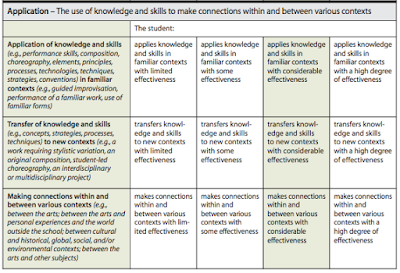Assessment Resources - Part 2
Performance Standards: The Achievement Chart (Chapter 3)
An achievement chart is a standardized way of assessing curriculum expectations. The achievement charts are divided into several categories. First, they are divided into 4 types of knowledge and skills (page 17).
Beginning on page 20 there are several samples of what an achievement chart looks like. Below is a sample of an achievement chart for the arts: grade 1-8.
This achievement chart allows for a standardized way of assessing student work and prevents norm-referenced assessment.
Several boards have created resources for both parents and teachers. For example, this is a resource for parents developed by York Region District School Board and this is a summary of all achievement charts organized by the Ontario Ministry of Education.
In my own personal practice I want my students to regularly meet, and exceed, expectations and feel accomplished and confident in their academic abilities. I will achieve this by sharing success criteria/achievement charts with students regularly so they know exactly what is expected of them.
- Knowledge and understanding: subject-specific content acquired in each grade/course (knowledge), and the comprehension of its meaning and significance (understanding).
- Thinking: the use of critical and creative thinking skills and/or processes.
- Communication: the conveying of meaning through various forms.
- Application: the use of knowledge and skills to make connections within and between various contexts.
- Level 1: achievement that falls much below the provincial standard. The student demonstrates the specified knowledge and skills with limited effectiveness. Students must work at significantly improving learning in specific areas, as necessary, if they are to be successful in the next grade/course.
- Level 2: achievement that approaches the provincial standard. The student demonstrates the specified knowledge and skills with some effectiveness. Students performing at this level need to work on identified learning gaps to ensure future success.
- Level 3: the provincial standard for achievement. The student demonstrates the specified knowledge and skills with considerable effectiveness. Parents of students achieving at level 3 can be confident that their children will be prepared for work in subsequent grades/courses.
- Level 4: achievement that surpasses the provincial standard. The student demonstrates the specified knowledge and skills with a high degree of effectiveness. However, achievement at level 4 does not mean that the student has achieved expectations beyond those specified for the grade/course.
The levels are qualified using specific language. The qualifier limited is used for level 1; some for level 2; considerable for level 3; and a high degree of or thorough for level 4.
Beginning on page 20 there are several samples of what an achievement chart looks like. Below is a sample of an achievement chart for the arts: grade 1-8.
 |
| Growing Success (2010). The Achievement Chart for The Arts: Grades 1-8 [Online Image]. Retrieved from: http://bit.ly/1LWtQPl |
Several boards have created resources for both parents and teachers. For example, this is a resource for parents developed by York Region District School Board and this is a summary of all achievement charts organized by the Ontario Ministry of Education.
In my own personal practice I want my students to regularly meet, and exceed, expectations and feel accomplished and confident in their academic abilities. I will achieve this by sharing success criteria/achievement charts with students regularly so they know exactly what is expected of them.




Comments
Post a Comment